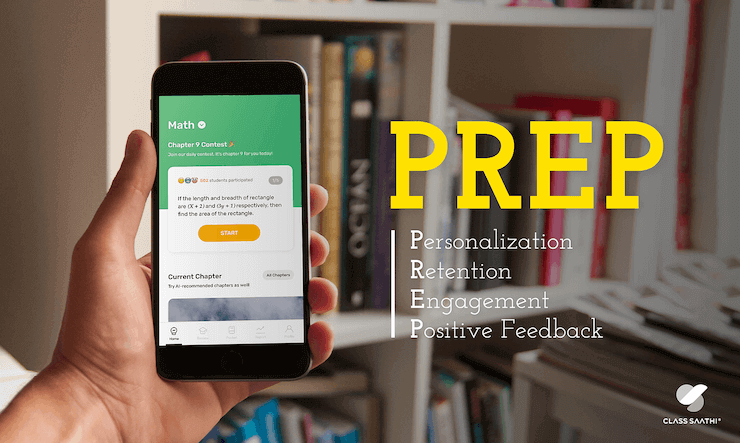Learning science and mathematics is like wearing a new pair of shoes - one size does not fit all. Students need a personalized program of study that provides quality instruction to fit their ability and learning needs. That is why I created the Class Saathi app - to give students individualized education no matter where they are.
To achieve this goal, my team and I designed Class Saathi around the research-supported framework of Personalization, Retention, Engagement, and Positive Feedback. Together, these four pillars of PREP ensure that students receive the focused instruction they need while retaining what they learn.

The first pillar of Personalization truly sets Class Saathi apart from the rest. Thanks to the artificial intelligence (AI) algorithms of Class Saathi, students are given questions based on their personal progress.
This means the AI recognizes the specific skills and knowledge that a student lacks and gives the student directed questions to improve these areas. Likewise, if a student has already demonstrated mastery of a specific skill, the AI will not waste their time by testing that skill again and again.
In addition to the personalized questions, Class Saathi also gives students agency in their learning program. Educational research, such as Wenmoth’s 2014 study[1], points to “learner agency” as a crucial way to help increase engagement and understanding of a lesson.
On the Class Saathi app, students can self-direct their learning through choices of learning level, question difficulty, length of quizzes, and timing options. This allows students to focus on what will help them achieve their learning goals fastest.
While Personalization gives students directed instruction, Retention demonstrates how their learning will stick. Class Saathi keeps new knowledge and skills from fading through the implementation of spaced repetition.
Cognitive research[2] shows that just like the need for repeated training to build muscle, remembering something we learn also requires daily practice. Instead of simply asking questions in a fixed order, the Class Saathi app builds students’ long-term memory by bringing back questions that they got wrong in a previous session. Thus, these new skills and knowledge will build stronger connections within students’ brains.
If Retention is the proof that Class Saathi is effective, Engagement is the proof that Class Saathi is effective for children. According to research on educational technology[3], motivation and encouragement techniques not only keep students using the app but also help them learn faster. With Class Saathi, positive encouragement is built into all areas of the app.
When students complete contests and chapters, they will earn badges and receive encouraging messages and visuals. In addition, students can track their progress in the chapter and see in real-time how much they are learning. This all contributes to the successful learning environment of the Class Saathi app.
Finally, the PREP pillar that complements Retention is Positive Feedback. Pedagogical research demonstrates how feedback is essential for student learning[4]. Class Saathi takes feedback to the next level by not only showing students which answers they got correct or incorrect, but also by providing detailed explanations for how to answer each question.
This means that students can efficiently learn from their mistakes. In addition, the app provides a database of all questions a student has answered so they can easily review their work.
Now, more than ever, it is vital that students have access to quality instruction when they are not in a formal classroom. Thanks to the research-supported framework of Personalization, Retention, Encouragement, and Positive Feedback, the Class Saathi app gives students high-quality learning through an effective program of study. Rather than memorizing by rote from a list, our students can prepare the smart way with Class Saathi.
[1] Wenmoth, D. "Trend 1: Learner Agency." (2014).
[2] Kang, Sean HK. "Spaced repetition promotes efficient and effective learning: Policy implications for instruction." Policy Insights from the Behavioral and Brain Sciences 3.1 (2016): 12-19.
[3] Garris, Rosemary, Robert Ahlers, and James E. Driskell. "Games, motivation, and learning: A research and practice model." Simulation & gaming 33.4 (2002): 441-467
[4] Gold E.M. Language identification in the limit. Information and Control. 1967;10:447–474.

